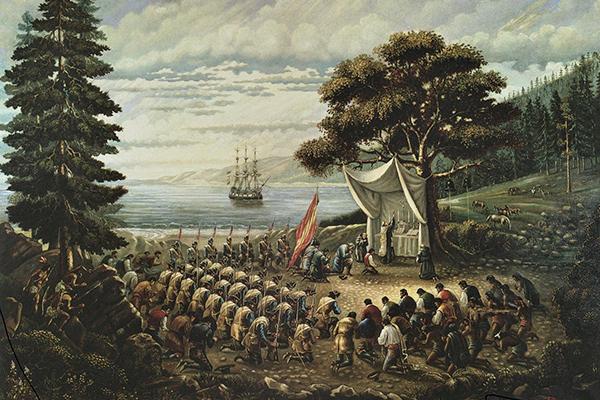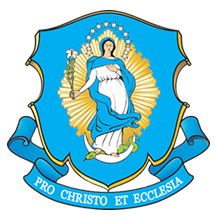
"Father Serra Celebrates Mass at Monterey" by Léon Trousset, 1877. Public domain.
“Go out to people of every nation! … Go forth and proclaim the good news! … Go forth and anoint!”
By Kimberly Bruce
“Siempre adelante! Keep moving forward!”
This was the motto of St. Junípero Serra (feast day: July 1), considered the “Apostle of California.” He was responsible for establishing 21 missions throughout the modern-day state in the 18th century and converting thousands of native Americans to the Catholic faith. He also worked tirelessly to defend those natives against ill-treatment by military and civil authorities.
“He was the embodiment of ‘a Church which goes forth,’ a Church which sets out to bring everywhere the reconciling tenderness of God,” said Pope Francis during the canonization Mass at the Basilica of the National Shrine of the Immaculate Conception in Washington, D.C., in 2015. He made the natives “his brothers and sisters . . . and sought to defend the dignity of the native community, to protect it from those who had mistreated and abused it.”
In Fr. Junípero, we find a true “mercy priest.” He forsook everything in his life, including physical health and comforts, to give his life as a missionary for others.
Missionary from Spain
He was born Miguel José Serra on Nov. 24, 1713, to farming parents Antonio and Margarita in Petra on the island of Majorca, Spain. A great student, Miguel became a professor of philosophy at a Franciscan monastery, and then entered as a novice in 1730 at the Convent of Jesus near Palma. There, he took the name Junípero after St. Francis’ companion, Br. Juniper. He was ordained a priest around 1738 at age 25.
He went on to obtain a doctorate in theology in 1742 from Lullian University in Palma and became theology chair there.
In April 1749, Fr. Junípero decided to become a missionary to the natives of the New World. He arrived first in Mexico and chose to walk 250 miles from the coast to Mexico City. Along the way, he was bitten by a scorpion, which caused a bad infection in his leg. This wound never properly healed and was the source of great suffering for Fr. Junipero for the rest of his life.
Father Junípero volunteered to minister to the remote Sierra Gorda Indian missions in 1750 and learned the native Pame language. Over the next nine years, he taught the natives to farm, tend livestock, domesticate animals, and develop commerce. He also translated the Catechism to aid their evangelization in the faith.
California
This was the model for the missions Father began to establish missions in California. The first was in San Diego in 1769. California at this time was ruled by Spain, and would not become part of the United States until 1850.
When a terrible food shortage occurred, putting a damper on future missions, Fr. Junípero and a fellow friar began a novena to St. Joseph. At the conclusion of the novena on March 19, the Solemnity of St. Joseph, a ship arrived, bringing much-needed supplies.
Father and his team moved up the coast. Missions were next established in San Carlos, Monterey/Carmel, San Antonio, San Gabriel, San Luís Obispo, San Francisco, San Juan Capistrano, Santa Clara, and San Buenaventura. Twelve more were founded after his death in 1784.
Beloved
Father Junípero was loved by the people. He preached, was a man of great prayer, and took upon himself many mortifications. In his zeal to bring souls to repentance he often scourged himself, pounded his breast with a stone, or took a lit torch to his chest to impress upon the people the need for penance.
He wrote many letters and a Diario of his journey from Loreto to San Diego. He suffered much from leg ulcers. Often, Fr. Junípero was unable to stand, let alone walk. He also suffered from asthma.
After serving as a missionary in the New World for 35 years, Fr. Junípero died at age 70 on August 28, 1784.
In 1884, the California legislature made Aug. 29, the centennial of his burial, a legal holiday. A granite monument was erected in his honor in Monterey, and a bronze statue of him was raised in Golden Gate Park in San Francisco.
Saint Junipero experienced what our Lord told St. Faustina about priests who would promote His mercy:
To priests who proclaim and extol My mercy, I will give wondrous power; I will anoint their words and touch the hearts of those to whom they will speak. (Diary of Saint Maria Faustina Kowalska, 1521.)
Controversy
In his lifetime, Fr. Junípero baptized more than 6,000 people and confirmed more than 5,000 in the faith, mostly Native Americans.
His accomplishments in spreading the Catholic faith have been overshadowed in recent years by many who accuse him of coercion, torture, and forced labor. In actuality, the natives were not slaves but indentured servants; they freely agreed to be taught various skills and trades at the mission, in return initially for service of the mission house. At times, since this was an unfamiliar arrangement, servants “fell down” on the job or even abandoned their posts. The missions could not survive unless such truancy was punished. After all, the work ethic and the sense of reciprocity were foreign concepts to the natives.
Above all, St. Junípero respected the native peoples. As Pope Francis stated at the canonization Mass:
Junípero Serra left his native land and its way of life. He was excited about blazing trails, going forth to meet many people, learning and valuing their particular customs and ways of life. He learned how to bring to birth and nurture God’s life in the faces of everyone he met; he made them his brothers and sisters. Junípero sought to defend the dignity of the native community, to protect it from those who had mistreated and abused it. Mistreatment and wrongs which today still trouble us, especially because of the hurt which they cause in the lives of many people.
Show mercy
Like St. Junípero, we need to be “movers” in proclaiming the Gospel. We do this by regaining, in Pope Francis’ words, “the conviction that we need one another, that we have a shared responsibility for others and for the world” (Laudato Si’, 229), and “For the source of our joy is ‘an endless desire to show mercy, the fruit of our own experience of the power of the Father’s infinite mercy” (Evangelii Gaudium, 24).
We are, said Pope Francis, to “Go out to people of every nation! … Go forth and proclaim the good news! … Go forth and anoint!”
Saint Junípero Serra, pray for us to “keep moving forward,” and tell the “good news”!
Next in the series: Saint Kateri Tekakwitha, July 14.
Previous article
{shopmercy-ad}
















